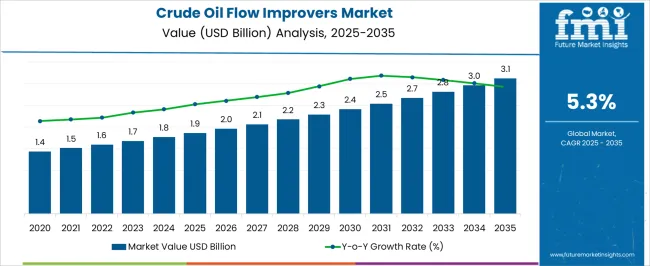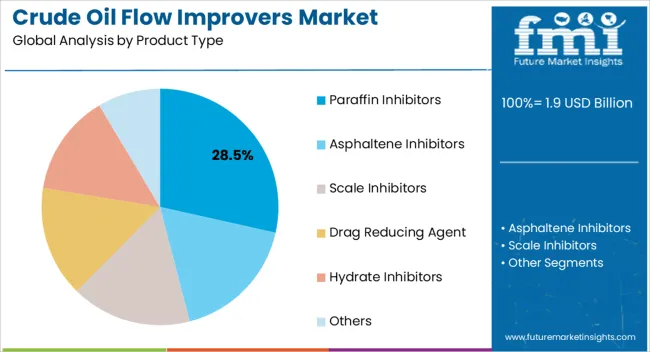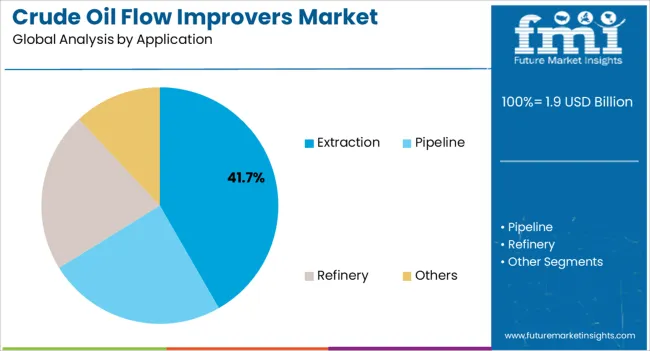The Crude Oil Flow Improvers Market is estimated to be valued at USD 1.9 billion in 2025 and is projected to reach USD 3.1 billion by 2035, registering a compound annual growth rate (CAGR) of 5.3% over the forecast period.

| Metric | Value |
|---|---|
| Crude Oil Flow Improvers Market Estimated Value in (2025 E) | USD 1.9 billion |
| Crude Oil Flow Improvers Market Forecast Value in (2035 F) | USD 3.1 billion |
| Forecast CAGR (2025 to 2035) | 5.3% |
The Crude Oil Flow Improvers market is experiencing steady growth, driven by increasing demand for efficient and uninterrupted crude oil transportation across pipelines and production facilities. Flow improvers are being adopted to address challenges related to wax deposition, paraffin crystallization, and viscosity increase in crude oil under low-temperature conditions. Advanced chemical formulations enhance crude oil fluidity, reduce pipeline blockages, and improve overall operational efficiency.
The market is further supported by rising crude oil production in both established and emerging regions, coupled with the need to optimize transportation logistics and reduce maintenance costs. Environmental and regulatory considerations, including efforts to minimize energy consumption and carbon footprint during oil transport, are encouraging the use of performance-enhancing chemicals.
Technological innovations in polymeric additives, paraffin inhibitors, and multi-functional formulations are enhancing product effectiveness As pipeline infrastructure expands and the demand for uninterrupted crude oil supply grows, the market for flow improvers is expected to witness sustained growth, with continuous innovation and integration of advanced chemistries driving adoption.
The crude oil flow improvers market is segmented by product type, application, and geographic regions. By product type, crude oil flow improvers market is divided into Paraffin Inhibitors, Asphaltene Inhibitors, Scale Inhibitors, Drag Reducing Agent, Hydrate Inhibitors, and Others. In terms of application, crude oil flow improvers market is classified into Extraction, Pipeline, Refinery, and Others. Regionally, the crude oil flow improvers industry is classified into North America, Latin America, Western Europe, Eastern Europe, Balkan & Baltic Countries, Russia & Belarus, Central Asia, East Asia, South Asia & Pacific, and the Middle East & Africa.

The paraffin inhibitors segment is projected to hold 28.5% of the market revenue in 2025, establishing it as the leading product type. Growth is being driven by their effectiveness in controlling paraffin wax deposition, which is a primary cause of pipeline blockages and reduced crude oil flow. Paraffin inhibitors modify wax crystal formation, ensuring smooth flow at low temperatures and minimizing maintenance and operational downtime.
The ability to deploy these inhibitors across diverse crude oil types and varying pipeline conditions enhances their applicability and preference among oil producers and pipeline operators. Continuous research and development in additive formulations have improved thermal stability, performance consistency, and environmental compatibility, further reinforcing adoption.
These inhibitors enable significant cost savings by reducing energy consumption for heating and preventing expensive cleaning operations As the demand for reliable and energy-efficient crude oil transportation continues to rise, paraffin inhibitors are expected to maintain their leading position, driven by their proven performance and operational benefits.

The extraction application segment is anticipated to account for 41.7% of the market revenue in 2025, making it the leading application area. Growth is being driven by the critical need to enhance crude oil recovery rates and maintain uninterrupted flow during production operations. Flow improvers facilitate the efficient transport of crude oil from wells to processing units by minimizing viscosity-related challenges and reducing pipeline blockages.
Adoption is further supported by the increasing complexity of extraction operations in mature and high-viscosity fields, where paraffin deposition and flow restrictions can significantly impact productivity. Continuous development of advanced chemical formulations and injection technologies has improved efficacy and operational flexibility.
The use of flow improvers in extraction also supports energy efficiency, reduces operational risks, and contributes to meeting regulatory standards As crude oil production continues to expand globally and operators seek cost-effective and reliable solutions, the extraction application segment is expected to remain the primary driver of market growth, supported by increasing operational efficiency and technological advancements.
According to Future Market Insights’ recent market study, the global market will be valued at US$ 1,679.9 Million by 2025. Crude Oil Improvers market value is expected to reach US$ 2,815.5 Million by 2035, with a steady growth rate of 5.3%.
| Attributes | Details |
|---|---|
| Market Size 2025 | US$ 1,679.9 Million |
| Market Size 2035 | US$ 2815.5 Million |
| Value CAGR (2025 to 2035) | 5.3% |
| Collective Value Share: Top 3 Countries (2025E) | 35% to 40% |
Crude oil is one of the most commonly traded commodities with a steady growth rate on a global scale. It is extracted by rigs in an offshore and onshore crude exploration model. Due to its viscosity and the need for an economical and effective method of transfer, crude oil transportation by pipeline is challenging. Therefore, it is crucial to maintain the viscosity of heavy oil for long-distance transportation without compromising the quality or state. The viscosity of crude oil is preserved during processing and transportation by crude oil flow improvers. It serves as an additive that provides suitable solutions at each stage of the extraction of crude oil, from the reservoir to the refinery, and helps to increase production. This additive is used as a drag-reducing compound and it is added to pipeline fluids for minimizing turbulence, preventing blockages and decreasing energy loss.
The market for crude oil flow improvers is being driven by the increase in global crude oil production to meet the rising demand. The demand for crude oil is increasing globally, and a large share of the world's energy basket is met by crude oil. The other non-renewable energy sources cannot provide the demand for energy on a global scale. Crude oil is needed to be delivered and used in an effective and efficient way because it is the main source of energy around the globe. These factors support the growth of the global market for crude oil flow Improvers.
Crude oil flow improvers also offer the best option for the three stages of exploration, transportation, and production refining. It is anticipated that a steady drop in crude oil prices and environmental issues will obstruct market expansion shortly. it is expected that stepping up research initiatives would lead to the creation of efficient and enormous market growth opportunities over the course of the forecasted year.

| Country | CAGR |
|---|---|
| China | 7.2% |
| India | 6.6% |
| Germany | 6.1% |
| France | 5.6% |
| UK | 5.0% |
| USA | 4.5% |
| Brazil | 4.0% |
The Crude Oil Flow Improvers Market is expected to register a CAGR of 5.3% during the forecast period, exhibiting varied country level momentum. China leads with the highest CAGR of 7.2%, followed by India at 6.6%. Developed markets such as Germany, France, and the UK continue to expand steadily, while the USA is likely to grow at consistent rates. Brazil posts the lowest CAGR at 4.0%, yet still underscores a broadly positive trajectory for the global Crude Oil Flow Improvers Market. In 2024, Germany held a dominant revenue in the Western Europe market and is expected to grow with a CAGR of 6.1%. The USA Crude Oil Flow Improvers Market is estimated to be valued at USD 654.4 million in 2025 and is anticipated to reach a valuation of USD 1.0 billion by 2035. Sales are projected to rise at a CAGR of 4.5% over the forecast period between 2025 and 2035. While Japan and South Korea markets are estimated to be valued at USD 94.8 million and USD 54.4 million respectively in 2025.

| Item | Value |
|---|---|
| Quantitative Units | USD 1.9 Billion |
| Product Type | Paraffin Inhibitors, Asphaltene Inhibitors, Scale Inhibitors, Drag Reducing Agent, Hydrate Inhibitors, and Others |
| Application | Extraction, Pipeline, Refinery, and Others |
| Regions Covered | North America, Europe, Asia-Pacific, Latin America, Middle East & Africa |
| Country Covered | United States, Canada, Germany, France, United Kingdom, China, Japan, India, Brazil, South Africa |
| Key Companies Profiled | Dorf Ketal Chemicals India Private Limited (India), Schlumberger, Clariant, Halliburton, Lubrizol Specialty Products, Inc., BASF SE, Baker Hughes, Nalco Champion, Infineum, Evonik Industries, ExxonMobil, Total S.A, British Petroleum, Weatherford International, and National Oil Varco |
The global crude oil flow improvers market is estimated to be valued at USD 1.9 billion in 2025.
The market size for the crude oil flow improvers market is projected to reach USD 3.1 billion by 2035.
The crude oil flow improvers market is expected to grow at a 5.3% CAGR between 2025 and 2035.
The key product types in crude oil flow improvers market are paraffin inhibitors, asphaltene inhibitors, scale inhibitors, drag reducing agent, hydrate inhibitors and others.
In terms of application, extraction segment to command 41.7% share in the crude oil flow improvers market in 2025.






Our Research Products

The "Full Research Suite" delivers actionable market intel, deep dives on markets or technologies, so clients act faster, cut risk, and unlock growth.

The Leaderboard benchmarks and ranks top vendors, classifying them as Established Leaders, Leading Challengers, or Disruptors & Challengers.

Locates where complements amplify value and substitutes erode it, forecasting net impact by horizon

We deliver granular, decision-grade intel: market sizing, 5-year forecasts, pricing, adoption, usage, revenue, and operational KPIs—plus competitor tracking, regulation, and value chains—across 60 countries broadly.

Spot the shifts before they hit your P&L. We track inflection points, adoption curves, pricing moves, and ecosystem plays to show where demand is heading, why it is changing, and what to do next across high-growth markets and disruptive tech

Real-time reads of user behavior. We track shifting priorities, perceptions of today’s and next-gen services, and provider experience, then pace how fast tech moves from trial to adoption, blending buyer, consumer, and channel inputs with social signals (#WhySwitch, #UX).

Partner with our analyst team to build a custom report designed around your business priorities. From analysing market trends to assessing competitors or crafting bespoke datasets, we tailor insights to your needs.
Supplier Intelligence
Discovery & Profiling
Capacity & Footprint
Performance & Risk
Compliance & Governance
Commercial Readiness
Who Supplies Whom
Scorecards & Shortlists
Playbooks & Docs
Category Intelligence
Definition & Scope
Demand & Use Cases
Cost Drivers
Market Structure
Supply Chain Map
Trade & Policy
Operating Norms
Deliverables
Buyer Intelligence
Account Basics
Spend & Scope
Procurement Model
Vendor Requirements
Terms & Policies
Entry Strategy
Pain Points & Triggers
Outputs
Pricing Analysis
Benchmarks
Trends
Should-Cost
Indexation
Landed Cost
Commercial Terms
Deliverables
Brand Analysis
Positioning & Value Prop
Share & Presence
Customer Evidence
Go-to-Market
Digital & Reputation
Compliance & Trust
KPIs & Gaps
Outputs
Full Research Suite comprises of:
Market outlook & trends analysis
Interviews & case studies
Strategic recommendations
Vendor profiles & capabilities analysis
5-year forecasts
8 regions and 60+ country-level data splits
Market segment data splits
12 months of continuous data updates
DELIVERED AS:
PDF EXCEL ONLINE
Crude Oil Assay Testing Services Market
Safflower Oil Market Size and Share Forecast Outlook 2025 to 2035
Ahiflower Oil Market Analysis – Growth & Forecast 2025 to 2035
Coil Assisted Flow Diverters Market – Growth, Demand & Forecast 2025 to 2035
Cold Flow Improvers Market Trends 2018-2027
Oily Waste Can Market Size and Share Forecast Outlook 2025 to 2035
Oil and Gas Seal Market Size and Share Forecast Outlook 2025 to 2035
Flower Box Market Size and Share Forecast Outlook 2025 to 2035
Oil Coalescing Filter Market Size and Share Forecast Outlook 2025 to 2035
Oil-immersed Iron Core Series Reactor Market Size and Share Forecast Outlook 2025 to 2035
Oil and Gas Sensor Market Forecast Outlook 2025 to 2035
Oil Packing Machine Market Forecast and Outlook 2025 to 2035
Oil and Gas Pipeline Coating Market Forecast and Outlook 2025 to 2035
Oilfield Scale Inhibitor Market Size and Share Forecast Outlook 2025 to 2035
Oil-in-Water Anionic Emulsifier Market Size and Share Forecast Outlook 2025 to 2035
Oil and Gas Field Services Market Size and Share Forecast Outlook 2025 to 2035
Flow Pack Films Market Size and Share Forecast Outlook 2025 to 2035
Flow Pack Machine Market Size and Share Forecast Outlook 2025 to 2035
Oil Control Shampoo Market Size and Share Forecast Outlook 2025 to 2035
Oil Expellers Market Size and Share Forecast Outlook 2025 to 2035

Thank you!
You will receive an email from our Business Development Manager. Please be sure to check your SPAM/JUNK folder too.
Chat With
MaRIA